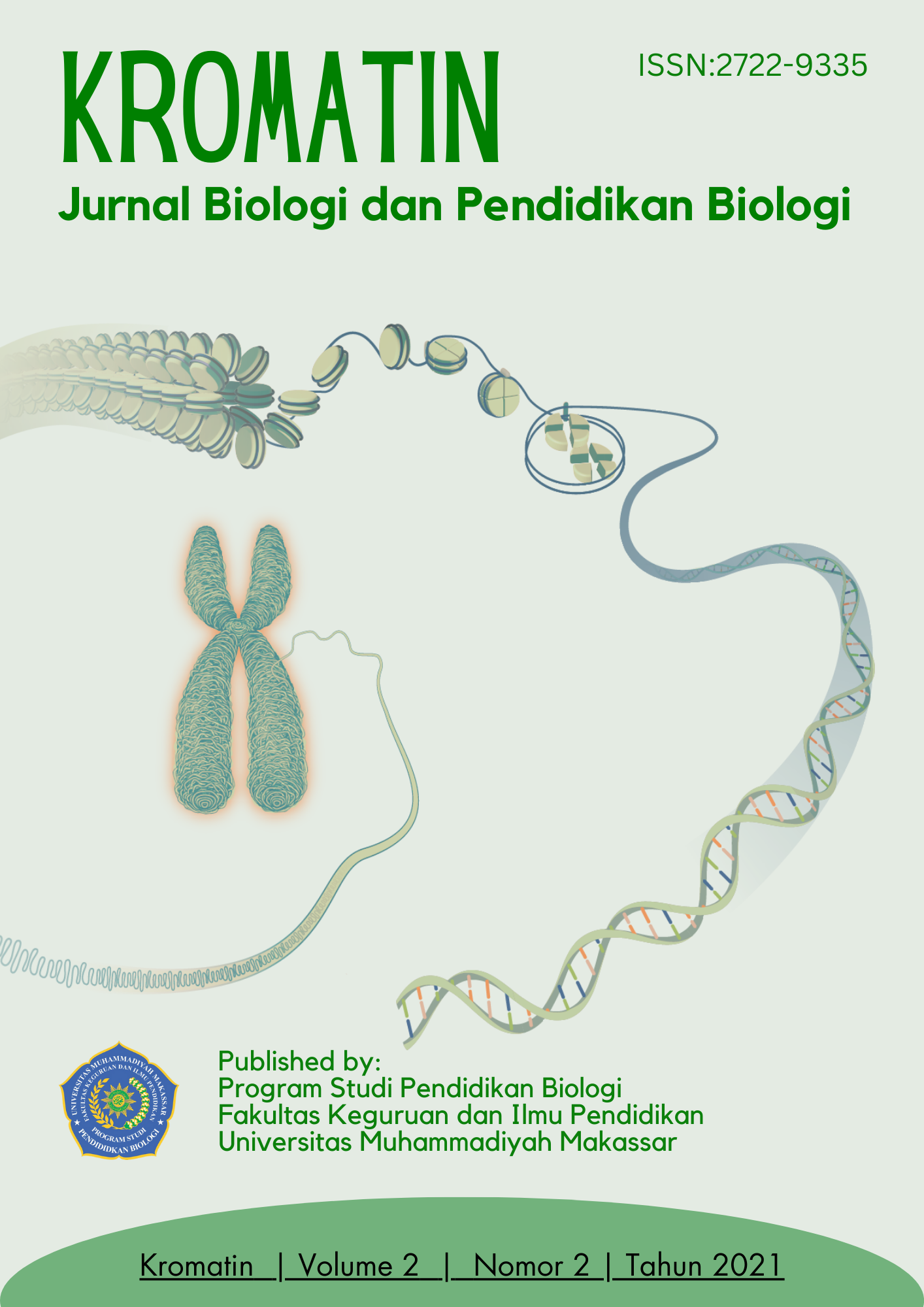Uji Validitas Pengembangan E-LKPD Berorientasi Hots Materi Sistem Pernapasan Sma Kelas Xi
Abstract
Electronic Student Worksheet (e-LKPD) oriented to Higher Order Thinking Skills (HOTS) on respiratory system material is the result of research and development. The purpose of this research is to produce a valid e-LKPD. This research is part of development research using the ADDIE model. The focus of the article is to discuss the validity test of the HOTS-oriented e-LKPD product that has been developed. The research was conducted in February 2022 at the Department of Biology, Faculty of Mathematics and Natural Sciences, Makassar State University. The research instrument used a validation sheet filled out by research subjects, namely 2 expert validator lecturers as validators from the Biology Department, FMIPA UNM. The data obtained were collected through analysis of the validation sheet which had been filled out by 2 expert validators. The process of data analysis was carried out using Microsoft Excel to obtain data in the form of a validity score. The results obtained indicate that the HOTS-oriented e-LKPD on respiratory system material has an average validity score of 4.62, based on this it is concluded that the HOTS-oriented e-LKPD on respiratory system material for class XI has met the valid criteria. Keywords: Validity, e-lkpd, hotsReferences
Adnan. 2015. Model Pembelajaran Biologi Konstruktivistik Berbasis TIK (MPBK Berbasis TIK) Untuk Siswa SMP. Journal of EST, 1(1) :1-11.
Adnan., & Bahri, A. 2011. Pengembangan Perangkat Pembelajaran Kontekstual Biologi pada Mata Pelajaran IPA Terpadu Berbasis Konstruktivisme untuk Pencapaian Standar Kompetensi Keanekaragaman Mahluk Hidup. Laporan Penelitian PNBP FMIPA UNM. Makassar: Universitas Negeri Makassar.
Adnan., Mulbar, U., Sugiarti, & Bahri, A. 2021. Biology Science Literacy of Junior High School Students in South Sulawesi, Indonesia. Journal of Physics: Conference Series, 1752 (1).
Adnan., Mulbar, U., Sugiarti., & Bahri, A. 2019. Biology Science Literacy of Junior High School Students in South Sulawesi, Indonesia. Journal of Physics: Conference Series, 1-8.
Adnan., Saenab, S., & Saleh, A.R. 2016. Unleash Students “Motivation with Blended Knowledge Transfer Instructional Model”. Proceedings of ICMSTEA 2016: International Conference on Mathematics, Science, Technology, Education, and their Applications, Makassar, Indonesia, 3rd – 4th, 240–243.
Budiastuti, D., & Bandur, A. 2018. Validitas dan Reliabitas Penelitian. Jakarta : Mitra Wacana Media.
Inderasari, E., Oktavia, W., Agustina, T., & Fajriyani, N. 2019. Higher Order Thinking Skill (HOTS) Taksonomi pada Analisis Kebahasaan Butir Soal Bahan Ajar Bahasa Indonesia Tingkat SMA/MA. Konferensi Nasional Bahasa dan Sastra (Konnas Basastra) V, 110-114.
Kurniawan, A. 2015. Pengembangan Lembar Kerja Peserta Didik (LKPD) Penyelesaian Soal Cerita Matematika Materi Bangun Datar Menggunakan Model Pembelajaran Bruner di Kelas V Sekolah Dasar. Skripsi. Universitas Muhammadiyah Purwokerto.
Lindira. 2019. Instrumen Penilaian & Validasinya. (n.d.). (n.p.): Uwais Inspirasi Indonesia.
Magdalena, I., Sundari, T., Nurkamilah, S., Nasrullah, & Amalia, D.A. 2020. Analisis Bahan Ajar. Nusantara : Jurnal Pendidikan dan Ilmu Sosial, 2(2), 311–326.
Nurfaida., Ali, M.S., & Abdullah, H. 2020. Pengembangan Lembar Kerja Peserta Didik Berbasis Multi Representasi pada Peserta Didik Kelas XI SMAN 1 Gowa. Jurnal Sains dan Pendidikan Fisika (JSPF) Jilid 16, 2 : 117-126.
Salim. 2019. Penelitian Pendidikan: Metode, Pendekatan, dan Jenis. Jakarta: Kencana.
Sani, A., & Ridwan. 2019. Pembelajaran Berbasis HOTS. Medan : TSmart.
Sitti. A.S., Muhammad, M., & Zaid, A.W. 2021. Pengantar Pengembangan Bahan dan Media Ajar. Surakarta :Muhammadiyah University Press.
Subadar. 2017. Penguatan Pendidikan Karakter (PPK) Berbasis Higher Order Thinking Skills (HOTS). Jurnal Pedagogik, 4 (1): 81-93.
Sudijono, A. 2008. Pengantar Evaluasi Pendidikan. Jakarta: Raja Grafindo Persada.
Downloads
Published
Issue
Section
License
Authors who publish with this journal agree to the following terms:
1. Authors retain copyright and grant the journal right of first publication with the work simultaneously licensed under a Creative Commons Attribution 4.0 Internasional License that allows others to share the work with an acknowledgement of the work's authorship and initial publication in this journal.
2. Authors are able to enter into separate, additional contractual arrangements for the non-exclusive distribution of the journal's published version of the work (e.g., post it to an institutional repository or publish it in a book), with an acknowledgement of its initial publication in this journal.
3. Authors are permitted and encouraged to post their work online (e.g., in institutional repositories or on their website) prior to and during the submission process, as it can lead to productive exchanges, as well as earlier and greater citation of published work.
Licence:
Authors are free to:
1. Share: Copy and redistribute the material in any medium or format
2. Adapt: Remix, transform, and build upon the material for any purpose, even commercially.
The licensor cannot revoke these freedoms as long as the authors follow the license terms, which include the following:
1. Attribution: Authors must give appropriate credit, provide a link to the license, and indicate if changes were made. Authors may do so in any reasonable manner, but not in any way that suggests the licensor endorses the authors or authors’ use.
2. No additional restrictions: Authors may not apply legal terms or technological measures that legally restrict others from doing anything the license permits.
This work is licensed under a licensed under a Creative Commons Attribution 4.0 Internasional License/ CC BY 4.0.


